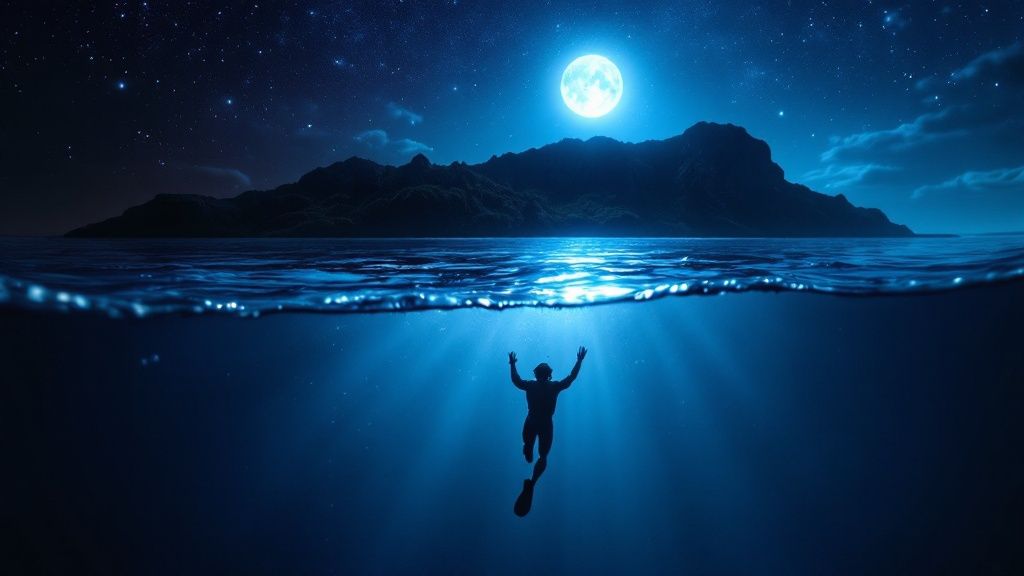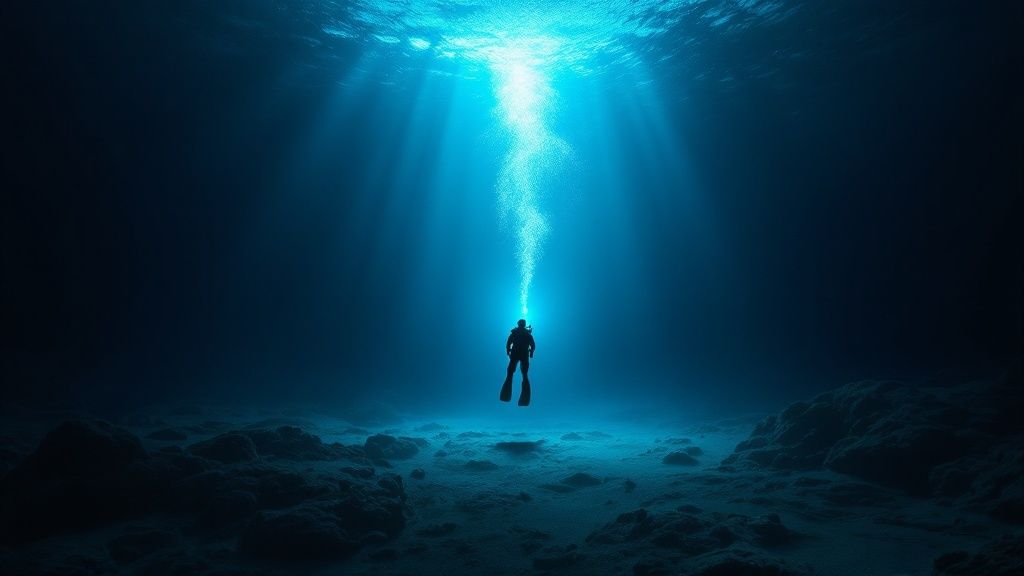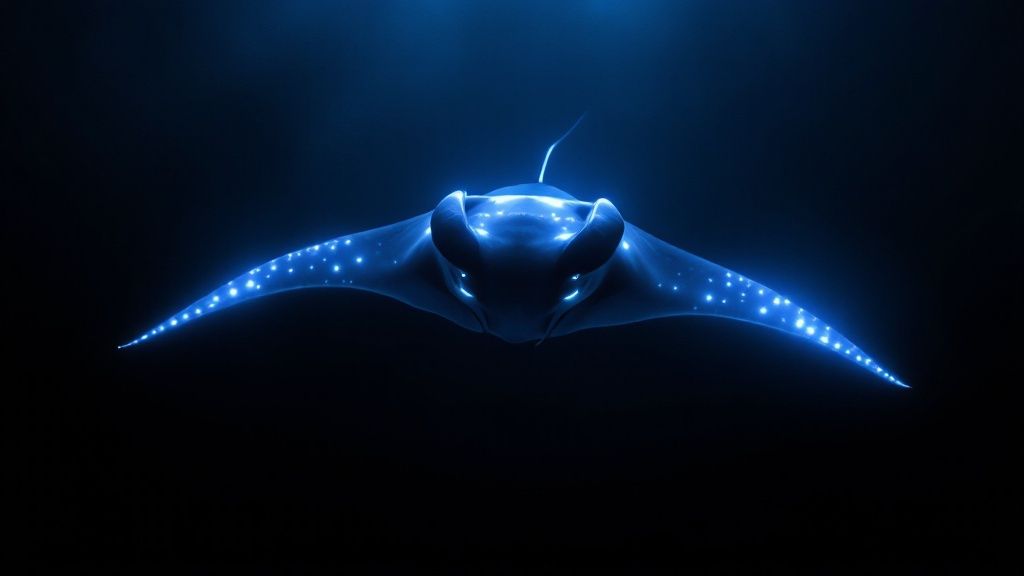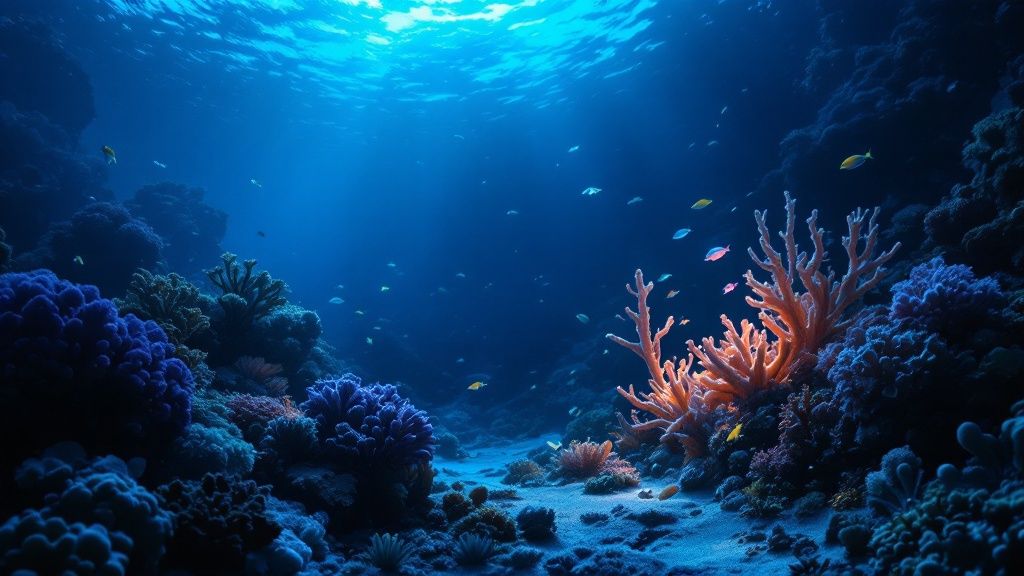The Underwater Ballet: Experiencing Manta Magic

The Big Island manta ray night dive is more than just a dive; it's an experience unlike any other. Imagine yourself entering the dark Pacific Ocean, surrounded by the faint glow of plankton. Suddenly, massive manta rays appear, their impressive wingspans illuminated by dive lights, creating a mesmerizing underwater ballet. It's this magical encounter that draws people worldwide to this unique experience.
Why Kona? The Manta Ray Hotspot
The Big Island of Hawaii, specifically Kona, has become the premier destination for manta ray night dives. However, this wasn't always the case. The activity started gaining popularity in the early 1990s, with the first organized dives occurring around 1991 near the Kona Surf Hotel. Since then, the number of Big Island manta ray night dives has grown significantly, with various operators offering trips almost nightly. These dives provide divers and snorkelers with an unforgettable opportunity to observe manta rays feeding on plankton attracted by the dive lights. Popular locations today include Garden Eel Cove and Manta Village, both often teeming with other marine life. For a deeper dive into the history of these dives, check out this resource: Learn more about the history of Manta Ray Night Dives.
How It Works: From Darkness To Light
The process behind a Big Island manta ray night dive is remarkably simple yet effective. Divers and snorkelers gather at the surface, often holding onto a submerged platform equipped with special lights. These lights attract plankton, the manta ray's main food source. As the plankton gathers, the mantas follow, creating an awe-inspiring natural spectacle.
A Dance For Everyone: Divers and Snorkelers
One of the best aspects of the Big Island manta ray night dive is its accessibility. Both certified divers and snorkelers can participate in this extraordinary experience. Divers typically descend to the ocean floor, watching the mantas glide and feed above. Snorkelers remain at the surface, often holding onto a flotation device, enjoying a close-up view of the manta rays as they perform their elegant underwater ballet. This means that regardless of your diving experience, you can witness this marine marvel. The experience caters to everyone, offering a truly personal connection with these gentle giants.
The Impact: More Than Just A Dive
The Big Island manta ray night dive has a far-reaching impact beyond the individual encounter. It fosters a deep respect for these incredible creatures and the delicate marine ecosystem they call home. Many describe a significant change in perspective, becoming passionate ocean advocates. This connection inspires a desire to protect these animals and their habitat, creating a positive feedback loop of awareness and conservation. These dives aren't just entertainment; they're a gateway to understanding and preserving our oceans. They offer a real connection to nature, inspiring a sense of responsibility that lasts long after the dive is over.
Nature's Choreography: The Science Behind the Magic

The graceful movements of manta rays during a Big Island manta ray night dive are nothing short of breathtaking. But these movements aren't random. They're part of a fascinating interplay between biology and the environment. Understanding this intricate dance transforms the experience from simple observation into active participation in a natural wonder.
The Plankton Connection: A Feast of Light
The key to this mesmerizing display? Plankton. These microscopic organisms, the very foundation of the marine food web, are drawn to light. Specialized lights used during Big Island manta ray night dives create a concentrated "plankton soup." This attracts the manta rays, who come to feast.
This method provides a predictable and reliable way to observe these magnificent creatures. The scientific principle is simple yet remarkably effective: attract the plankton, and the manta rays will follow. It creates a mesmerizing spectacle, allowing incredibly close encounters with these gentle giants.
Dive sites like Garden Eel Cove are typically around 35 feet deep, with water temperatures ranging from 75 to 79 degrees Fahrenheit. The experience is not only thrilling but also contributes to research on manta ray behavior and population dynamics. Learn more about this incredible experience at Kona Honu Divers.
Manta Adaptations: Perfectly Designed for Plankton Harvesting
Manta rays have evolved unique adaptations specifically for consuming plankton. Their cephalic fins, positioned on either side of their mouths, act as funnels, guiding the plankton-rich water inwards.
Their gill rakers then filter out the plankton, allowing the manta ray to efficiently consume vast quantities of these tiny organisms. Their entire physiology is perfectly optimized for this unique feeding strategy.
Kona's Unique Environment: The Ideal Stage
Kona's oceanographic conditions create a perfect environment for these nightly feeding displays. The nutrient-rich waters surrounding the Big Island support abundant plankton populations, providing a constant food source for the manta rays.
The typically calm waters and relatively shallow dive sites offer ideal visibility. These factors contribute to Kona’s well-deserved reputation as a world-renowned location for manta ray night dives.
Electromagnetic Sensitivity: A Hidden Sense
Manta rays possess a remarkable sensitivity to electromagnetic fields. This helps them detect the faint electrical signals produced by plankton and other marine life, aiding in their search for food.
This sensitivity also explains their curious behavior around divers. They can sense the electrical fields generated by our dive equipment. Understanding this hidden sense provides further insight into their complex relationship with their environment.
Research and Conservation: Beyond the Spectacle
Big Island manta ray night dives also offer a unique opportunity for scientific research. Researchers use these dives to gather data on manta ray behavior, population dynamics, and individual identification through unique spot patterns.
This research is vital for ongoing conservation efforts. By participating in a Big Island manta ray night dive, you indirectly contribute to valuable scientific research, helping protect these gentle giants and their habitat.
Prime Locations: Where Manta Magic Happens

Not all Big Island manta ray night dive sites are the same. Each spot offers a different experience, shaped by the underwater landscape, currents, and how much plankton is around. Knowing these differences helps you pick the right site for your diving skills and the kind of manta encounter you’re looking for.
Manta Village: The Original Hotspot
Manta Village, just off the coast of the Sheraton Keauhou Bay Resort & Spa, is where it all began. This site is famous for its high rate of manta sightings. Back in 2013, 96% of tours saw manta rays at Manta Village, with an average of four mantas per night. This reliability makes it a favorite for first-time divers and snorkelers. The shallow depth and calm waters also make it easy and enjoyable.
Garden Eel Cove (Manta Heaven): A Thriving Metropolis
North of Kona, near the Kona International Airport, is Garden Eel Cove, also called Manta Heaven. While the manta sighting rate is slightly lower than Manta Village at 90%, you often see bigger groups of mantas here. This location averaged 11 mantas per night in 2013. Imagine a mesmerizing manta "ballet" with multiple rays gracefully feeding in the light.
Kohala Coast: An Intimate Encounter
If you want a more private experience, head to the Kohala Coast near Waikoloa Village and the Kohala Resorts. Fewer people dive here, so you might even have a one-on-one encounter with a manta ray. Manta sightings are less frequent, but the tranquility is worth it. This site is best for experienced divers and snorkelers seeking a peaceful, secluded dive.
To help you choose the right site, here's a handy comparison table:
Big Island Manta Ray Dive Site Comparison: This table compares the main manta ray night dive locations on the Big Island, highlighting key features and characteristics of each site.
| Dive Site | Location | Average Depth | Typical Manta Count | Best For | Other Marine Life |
|---|---|---|---|---|---|
| Manta Village | Sheraton Keauhou Bay Resort & Spa | Shallow | 4 | Beginners, Photographers | Reef fish, sea turtles, dolphins |
| Garden Eel Cove (Manta Heaven) | North of Kona International Airport | Moderate | 11 | Experienced Divers/Snorkelers, Photographers | Garden eels, Heller's barracuda, reef fish |
| Kohala Coast | Waikoloa Village and Kohala Resorts | Varies | Fewer than other sites | Experienced Divers/Snorkelers seeking seclusion | Invertebrates, fish, octopus |
As you can see, each site has its own charm. Choose the one that best suits your experience level and what you want to see.
Choosing the Right Site for You
- Beginners: Manta Village offers calm, shallow waters and a high chance of seeing mantas.
- Experienced Divers/Snorkelers: Garden Eel Cove and the Kohala Coast offer more challenging dives and the potential for special encounters.
- Photographers: Manta Village and Garden Eel Cove provide fantastic photo opportunities of manta rays feeding.
Beyond the Mantas: Other Marine Life
While the manta rays are the main attraction, there’s a lot more to see at each site.
- Manta Village: You might see colorful reef fish, sea turtles, and even dolphins.
- Garden Eel Cove: True to its name, this site has a colony of garden eels, creating a captivating display as they sway in the current. You might also see Heller's barracuda and various other reef creatures.
- Kohala Coast: The rocky reefs and sandy bottom are home to diverse invertebrates, fish, and the occasional octopus.
Knowing the special qualities of each site helps you plan an unforgettable manta ray night dive. Whether you’re a seasoned diver or a first-time snorkeler, Kona’s manta rays are ready to amaze you. For an exceptional trip, book your tour with Kona Honu Divers, known for their ethical practices and maximizing encounter opportunities.
Perfect Timing: Maximizing Your Manta Encounter

Planning a Big Island manta ray night dive is more than just booking a tour; timing is key to an unforgettable experience. While these gentle giants are present year-round, understanding seasonal nuances and environmental factors can significantly enhance your encounter.
Dispelling the Myth of Seasonality
Many believe manta rays migrate like whales. This is a misconception. Kona's manta rays are residents, gracing the Big Island's waters year-round. However, several factors influence their feeding behaviors and visibility during dives.
Despite their constant presence, there are periods with fewer manta sightings. Data from Kona Honu Divers shows manta rays appear during over 80% of night dives, with an average of 6 mantas per night. However, there's a 19% chance of no mantas showing up at all.
This unpredictability makes each sighting feel special. The number of mantas can also vary dramatically, with record nights exceeding 36 mantas at once. For detailed statistics, check out the Kona Honu Divers Manta Ray Statistics.
Lunar Cycles and Plankton: The Manta Magnet
The moon significantly impacts manta ray feeding. Plankton, their primary food source, is affected by lunar cycles. Brighter moon phases disperse plankton, making it harder for mantas to find concentrated food near dive lights.
Conversely, darker nights create tighter plankton clusters, increasing the chance of spectacular manta feeding displays. This makes planning around the lunar cycle a smart move.
Ocean Currents and Visibility: A Clear Advantage
Ocean currents and weather directly affect water visibility – a critical factor for a memorable dive. Calmer seas typically mean clearer water, providing optimal manta viewing.
While Kona usually enjoys calm conditions, occasional storms or strong currents can impact visibility. Checking local weather forecasts before your dive helps manage expectations.
Tourist Seasons vs. Optimal Viewing Conditions: Finding the Balance
Peak tourist seasons often coincide with summer and holidays. While tours are readily available, dive sites can be crowded. Consider visiting during the shoulder seasons (spring or fall) for a potential balance of good viewing and fewer people. This allows for a more tranquil experience.
Booking Flexibility and Backup Options: Planning for the Unpredictable
Nature is unpredictable. Even with meticulous planning, unforeseen factors can impact your dive. Booking your manta ray night dive early in your trip offers flexibility for rescheduling.
Having a backup plan ensures an encounter-less night isn't a complete disappointment. Consider alternative activities you can enjoy if your dive is affected.
Interpreting Weather Forecasts: Manta-Specific Considerations
Standard weather forecasts may not address manta-specific conditions. Look for reports detailing water visibility, wave height, and current strength. These give a more accurate picture of how conditions might influence your encounter.
Consulting local dive operators like Kona Honu Divers provides invaluable insights into current conditions and ideal booking times. Their expertise can make all the difference.
Beyond Entertainment: Conservation in Action
The magic of a Big Island manta ray night dive isn't just about the personal thrill. It plays a vital role in manta ray conservation efforts. Working with researchers and marine specialists, these dives significantly contribute to protecting these gentle giants.
From Tourist Data to Scientific Discovery
Every Big Island manta ray night dive provides valuable data. Commercial dive operators carefully record encounter information, which has proven invaluable to researchers. This data has transformed our understanding of manta ray population dynamics. Researchers can identify individual mantas through their unique spot patterns, similar to human fingerprints, and even track previously unknown migration routes. This citizen science approach, where tourists indirectly contribute to research, powerfully demonstrates how recreation and conservation can complement each other.
Threats and Protections: A Global and Local Perspective
Manta rays face significant global threats. These include bycatch in fishing nets, habitat destruction, and the effects of pollution and climate change. However, specific protective measures exist in Hawaiian waters. The manta ray night dive itself is carefully regulated to minimize disturbance. Strict guidelines ensure responsible interactions, protecting the mantas and their delicate ecosystem. This careful management ensures the long-term sustainability of these incredible encounters.
The Power of Education: Shaping Conservation Policy
Educating visitors is fundamental to manta ray conservation. Participating in a Big Island manta ray night dive gives individuals a deeper understanding of these creatures and the difficulties they face. This first-hand experience often turns casual observers into passionate advocates for marine protection. This growing public awareness is key in influencing conservation policy and bolstering protective legislation. Educated visitors can make informed decisions that benefit the environment.
Responsible Operators: Choosing Wisely
Choosing responsible operators is essential for supporting sustainable manta ray tourism. Look for operators dedicated to ethical practices, like following established guidelines, minimizing their environmental impact, and actively supporting research. Kona Honu Divers emphasizes responsible practices and educational outreach. Their tours benefit both visitors and manta ray protection. This collaborative approach ensures the manta ray night dive remains sustainable and educational. Conservation is vital for the health and sustainability of manta ray populations in Kona. Guidelines from organizations like the Ocean Recreation Council of Hawaii and Project AWARE from PADI are strictly enforced to protect the mantas during dives. Responsible tourism, supported by operators like Kona Honu Divers, helps fund research and conservation. The Manta Pacific Research Foundation is instrumental in studying manta rays in their natural habitat and promoting global conservation. Learn more about the importance of manta ray conservation here.
Supporting Research: Beyond the Dive
Your contribution to manta ray conservation doesn't stop when the dive ends. Organizations like the Manta Pacific Research Foundation rely on public support for their vital research. Donating to these organizations, sharing your experiences, and advocating for responsible tourism are all practical ways to support ongoing efforts. Every action, no matter how seemingly small, helps ensure the long-term survival of these magnificent creatures and their ocean home. This continued engagement ensures future generations can experience the magic of the manta ray night dive.
Community Impact: Beyond the Tourist Experience
The Big Island manta ray night dive is more than a magical encounter. It's an integral part of the island's economy and community fabric. This sustainable tourism practice offers essential livelihoods and actively promotes conservation, highlighting the symbiotic relationship between respecting nature and benefiting both people and the environment.
Economic Ripple Effects: From Ocean to Island
The economic impact of the Big Island manta ray night dive is substantial. It creates jobs, not only for dive operators and boat captains but also for related businesses. Think hotels, restaurants, and local transportation services. This influx of revenue helps diversify the local economy and creates opportunities for island residents. Furthermore, the emphasis on ecotourism encourages responsible business practices with a focus on environmental protection, fostering long-term economic stability for the community.
Conservation Through Commerce: Mantas Worth More Alive Than Dead
The manta ray night dive demonstrates the economic power of conservation. The Kona manta ray night dive has evolved into a significant economic driver, contributing millions of dollars annually. This provides a strong incentive for the preservation of these majestic creatures. Unlike other regions where mantas are tragically hunted for their gill rakers, Kona's ecotourism proves that mantas are worth more alive than dead. This economic advantage supports conservation efforts and bolsters responsible tourism. Organizations like the Manta Pacific Research Foundation work tirelessly to protect local manta rays and educate the public about their ecological significance. This shift in perspective, from wildlife as a commodity to wildlife as an economic asset, fuels powerful protective measures.
Cultural Connections: Honoring Tradition
Indigenous Hawaiian perspectives significantly shape current tourism practices related to the manta ray night dive. The inherent Hawaiian respect for nature and the ocean is evident in the careful regulations and ethical guidelines surrounding these dives. This cultural sensitivity ensures the experience is not only enjoyable for visitors but also deeply respectful of the environment and the cultural importance of these graceful animals.
Education and Empowerment: Investing in the Future
The Big Island manta ray night dive further creates educational opportunities for young islanders. Local initiatives provide training and career paths in marine biology, conservation, and the tourism industry, empowering the next generation to become environmental stewards. These programs foster a deeper understanding of marine life and conservation, safeguarding the future of these gentle giants.
Research Partnerships: A Symbiotic Relationship
The manta ray night dive facilitates invaluable research partnerships. Data gathered during commercial dives benefits the scientific community, providing insights into manta ray behavior, migration patterns, and population dynamics. This knowledge directly informs conservation strategies and refines our ability to protect these animals and their fragile habitat. This collaboration between tourism and science establishes a truly symbiotic relationship where both sectors gain from shared knowledge and resources. Participating in a Big Island manta ray night dive isn’t just a unique experience; it's a direct contribution to a sustainable future for the island's community and its diverse marine life. This elevates the experience, transforming a simple tourist activity into a positive force for conservation and community well-being.
Preparing For Your Unforgettable Manta Ray Encounter
Transforming your Big Island manta ray night dive from simply "good" to truly extraordinary depends on preparation. From selecting an ethical tour operator to understanding equipment essentials and managing expectations, pre-dive planning is key. This section covers those important steps, incorporating insights from seasoned dive masters and underwater photographers.
Choosing The Right Operator: Ethics And Expertise
Your choice of operator significantly affects both your experience and the manta rays’ well-being. Ethical operators prioritize the animals' health and follow established guidelines. These guidelines, often created with organizations like the Ocean Recreation Council of Hawaii and Project AWARE, promote responsible interactions and minimize disturbances to the mantas and their surroundings. Responsible operators, for example, educate participants on appropriate in-water behavior, such as avoiding touching the mantas and keeping a respectful distance.
Exceptional operators go above and beyond the basics by actively supporting research and conservation efforts. They teach visitors about the fragile ecosystem and the challenges facing manta rays, turning a tourist activity into a conservation opportunity. Kona Honu Divers, known for their ethical practices and focus on maximizing encounter opportunities, exemplifies this commitment.
Managing Expectations: Nature's Element Of Surprise
While Big Island manta ray night dives have high success rates, it's important to remember these are wild animals in their natural environment. There's always a chance, however small, that mantas won’t appear during your dive. Operators like Kona Honu Divers sometimes have a "manta guarantee," letting you re-book if no mantas are seen on your first dive.
The number of mantas can also change. Kona Honu Divers’ data indicates mantas appear on over 80% of dives, with an average of 6 mantas per night. However, there's a 19% chance of not seeing any mantas, and the numbers can fluctuate, with some nights boasting over 36 mantas. This natural unpredictability highlights the importance of flexible booking and having backup plans.
Equipment Essentials: Comfort And Functionality
Having the right equipment enhances your comfort and enjoyment. While many operators provide gear, bringing your own personalized items can significantly improve the experience. Consider a wetsuit or extra layers, as even in Hawaii, the water cools at night.
A well-fitting mask and snorkel are essential for clear underwater views. If you’re prone to seasickness, take precautions like motion sickness medication before the dive. Photographers should have a secure underwater camera setup, like a GoPro with a float or wrist strap. Remember to prioritize the experience and avoid excessive camera use, especially flash photography, which can disturb the mantas.
In-Water Etiquette: Respect For Gentle Giants
Understanding appropriate in-water behavior is essential. Never touch the mantas; their skin is covered in a protective mucous layer vital for their immune system. Maintaining a safe distance lets them feed naturally without interference.
Divers should stay on or near the bottom, avoiding any contact with coral and other marine life. Snorkelers should remain on the surface and not dive down to the feeding mantas. Proper light usage – directed upwards by divers and downwards by snorkelers – attracts plankton without disorienting the mantas. These guidelines ensure a respectful and minimally disruptive encounter, benefitting both participants and the manta rays.
Specialized Advice: Photography, Families, And Beginners
- Photography: Use natural light and avoid flash photography. Position yourself for the best shots without disturbing the mantas.
- Families with Children: Choose operators experienced with younger snorkelers. Ensure children are comfortable in the water and understand safety procedures.
- Beginners: Select a site like Manta Village with calm, shallow waters and a high manta sighting rate. Talk to the crew about any concerns and consider a flotation device.
To help you prepare, we’ve compiled a helpful checklist:
Manta Ray Night Dive Preparation Checklist: A comprehensive checklist of items to prepare and consider before your manta ray night dive experience.
| Category | For Divers | For Snorkelers | Notes |
|---|---|---|---|
| Operator | Research ethical and experienced operators | Same as divers | Prioritize sustainability and manta ray welfare |
| Booking | Book in advance, particularly during peak season | Same as divers | Book early in your trip to allow for flexibility |
| Gear | Wetsuit or thermal protection, dive lights | Wetsuit or thermal protection, snorkel gear, flotation device | Rent or bring your own |
| Medications | Motion sickness medication if needed | Same as divers | Take precautions if prone to seasickness |
| Camera | Underwater camera with float/strap, no flash | Same as divers | Respect the mantas; avoid excessive photography |
| Mental Preparation | Review safety procedures and manta ray etiquette | Same as divers | Stay calm and enjoy the experience |
This checklist covers the key aspects of preparing for your dive.
By following these preparation tips, you can maximize your chances of a memorable and ethical Big Island manta ray night dive, creating a truly magical experience while contributing to the conservation of these amazing creatures. For an exceptional adventure, book your tour with Kona Honu Divers, known for their dedication to customer satisfaction and responsible manta ray interactions.
